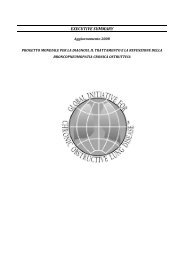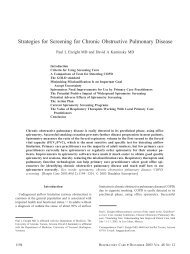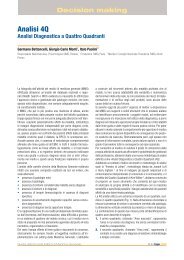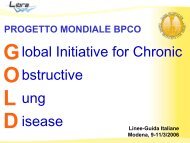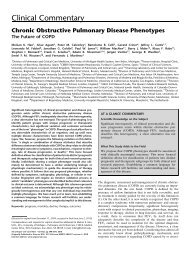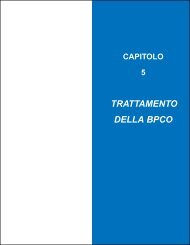Global Initiative for Chronic Obstructive Lung Disease - GOLD
Global Initiative for Chronic Obstructive Lung Disease - GOLD
Global Initiative for Chronic Obstructive Lung Disease - GOLD
Create successful ePaper yourself
Turn your PDF publications into a flip-book with our unique Google optimized e-Paper software.
<strong>GOLD</strong>_WR_05 8/18/05 12:56 PM Page 39<br />
Some pathological abnormalities, such as inflammation of<br />
the submucosal glands and hyperplasia of goblet cells,<br />
may contribute to chronic sputum production, although<br />
these pathological abnormalities are not present in all<br />
patients with this symptom.<br />
Dyspnea, an abnormal awareness of the act of breathing,<br />
usually reflects an imbalance between the neural drive to<br />
the respiratory muscles and the effectiveness of the<br />
resulting ventilation. Different individuals use different<br />
words to describe the feeling of breathlessness, which is<br />
also influenced by other factors such as mood. In COPD<br />
patients, dyspnea is mainly the result of impaired lung<br />
mechanics (increased airways resistance, decreased<br />
elastic recoil). It is only present on vigorous exercise in<br />
the early stages of disease but may be present at rest as<br />
the mechanical impairment becomes severe.<br />
PATHOLOGY AND<br />
PATHOPHYSIOLOGY OF<br />
EXACERBATIONS<br />
The progressive course of COPD is complicated by<br />
exacerbations that have many causes and occur with<br />
increasing frequency as the disease progresses.<br />
Pathology<br />
Distinguishing the pathology of these acute events from<br />
that of the underlying disease is difficult because patients<br />
experiencing an exacerbation are usually too ill to study.<br />
The limited evidence available suggests that mild COPD<br />
exacerbations are associated with increases of both<br />
neutrophils and eosinophils in sputum and biopsies, while<br />
severe COPD exacerbations are associated with an<br />
increase in sputum neutrophils and eosinophils 18,19 . At<br />
least in sputum, the changes in inflammatory cells during<br />
exacerbations of COPD are the same as those observed<br />
during exacerbations of asthma 115-119 . So far no study has<br />
been conducted examining the pathological abnormalities<br />
associated with fatal exacerbations of COPD, which can be<br />
considered the extreme end of the spectrum of severity.<br />
Pathophysiology<br />
Expiratory airflow is almost unchanged during mild<br />
exacerbations 18 , and only slightly reduced during severe<br />
exacerbations 120,121 . Although the pathophysiology of<br />
exacerbations is not fully understood, the primary<br />
physiological change in severe exacerbations is a further<br />
worsening of gas exchange, primarily produced by<br />
increased V A /Q inequality. As V A /Q relationships worsen,<br />
increased work of the respiratory muscles results in<br />
greater oxygen consumption, decreased mixed venous<br />
oxygen tension, and further amplification of gas<br />
exchange abnormalities 120 . Worsening of V A /Q relationships<br />
has several causes in exacerbations. Airway<br />
inflammation and edema, mucus hypersecretion, and<br />
bronchoconstriction may contribute to changes in the<br />
distribution of ventilation, while hypoxic constriction of<br />
pulmonary arterioles may modify the distribution of<br />
perfusion. Additional contributors to worsening gas<br />
exchange in exacerbations include abnormal patterns of<br />
breathing and fatigue of the respiratory muscles. These<br />
can cause further deterioration in blood gases and<br />
worsening of respiratory acidosis, leading to severe<br />
respiratory failure and death 120-123 . Alveolar hypoventilation<br />
also contributes to hypoxemia, hypercapnia, and<br />
respiratory acidosis. In turn, hypoxemia and respiratory<br />
acidosis promote pulmonary vasoconstriction, which<br />
increases pulmonary artery pressures and imposes an<br />
added load on the right ventricle.<br />
REFERENCES<br />
1. Finkelstein R, Fraser RS, Ghezzo H, Cosio MG. Alveolar<br />
inflammation and its relation to emphysema in smokers.<br />
Am J Respir Crit Care Med 1995; 152:1666-72.<br />
2. O'Shaughnessy TC, Ansari TW, Barnes NC, Jeffery PK.<br />
Inflammation in bronchial biopsies of subjects with chronic<br />
bronchitis: inverse relationship of CD8 + T lymphocytes with<br />
FEV 1 . Am J Respir Crit Care Med 1997; 155:852-7.<br />
3. Di Stefano A, Capelli A, Lusuardi M, Balbo P, Vecchio C,<br />
Maestrelli P, et al. Severity of airflow limitation is associated<br />
with severity of airway inflammation in smokers. Am J<br />
Respir Crit Care Med 1998; 158:1277-85.<br />
4. Keatings VM, Collins PD, Scott DM, Barnes PJ. Differences<br />
in interleukin-8 and tumor necrosis factor-alpha in induced<br />
sputum from patients with chronic obstructive pulmonary<br />
disease or asthma. Am J Respir Crit Care Med 1996;<br />
153:530-4.<br />
5. Thompson AB, Daughton D, Robbins RA, Ghafouri MA,<br />
Oehlerking M, Rennard SI. Intraluminal airway inflammation<br />
in chronic bronchitis. Characterization and correlation<br />
with clinical parameters. Am Rev Respir Dis 1989;<br />
140:1527-37.<br />
6. Lacoste JY, Bousquet J, Chanez P, Van Vyve T, Simony-<br />
Lafontaine J, Lequeu N, et al. Eosinophilic and neutrophilic<br />
inflammation in asthma, chronic bronchitis, and chronic<br />
obstructive pulmonary disease. J Allergy Clin Immunol<br />
1993; 92:537-48.<br />
7. Beeh KM, Beier J, Kommann O, Mander A, Buhl R. Longterm<br />
repeatability of induced sputum cells and inflammatory<br />
markers in stable, moderately severe COPD. Chest<br />
2003; 123:778-83.<br />
8. Stockley RA. Neutrophils and the pathogenesis of COPD.<br />
Chest 2002; 121:151S-155S.<br />
PATHOGENESIS, PATHOLOGY, AND PATHOPHYSIOLOGY 39


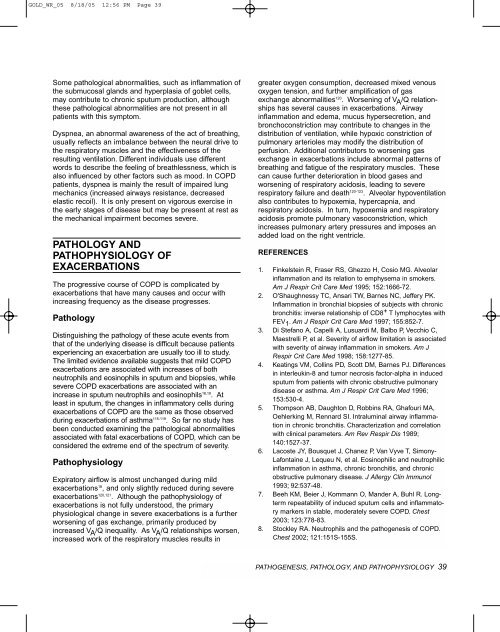
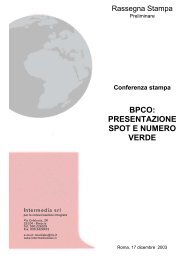
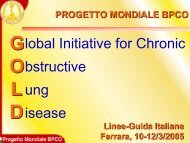
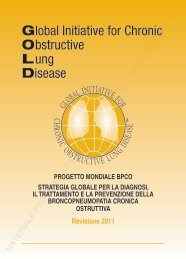
![Di Bari [NO].pdf - GOLD](https://img.yumpu.com/21544924/1/190x143/di-bari-nopdf-gold.jpg?quality=85)

